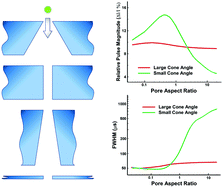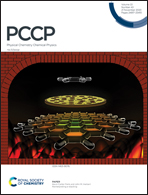Effects of cone angle and length of nanopores on the resistive pulse quality†
Abstract
Resistive pulse sensing (RPS) has proved to be a viable method for the detection and characterization of micro and nano particles. Modern fabrication methods have introduced different nanopore geometries for resistive pulse sensors. In this paper, we have numerically studied the effects of membrane thickness and the pore's cone angle, as the main geometrical parameters, on the sensing performance of the nanopores used for nanoparticle detection in the resistive pulse sensing method. To compare the sensing performance, three resistive pulse quality parameters were investigated – sensitivity, pulse duration and pulse amplitude. The thorough investigation on the relations between the geometrical parameters and the pulse quality parameters produced several interesting results, which were categorized and summarized for different nanopore structures (as different nanopore platforms) enabling the readers to more effectively compare them with one another. The results revealed that large cone angle and low aspect ratio nanopores have higher pulse amplitude and sensitivity, but their low duration could be a challenge in the process of detecting the resistive pulse. In addition, our results show small variation in sensitivity and duration of large cone angle nanopores with respect to pore length change, which is explained using the effective length concept and the definition of electric field strength and length. The findings of the present work can be used in practical applications where choosing the optimal pore geometry is of crucial significance. Furthermore, the results provide several possible ways to improve the resistive pulse quality for better sensing performance.



 Please wait while we load your content...
Please wait while we load your content...